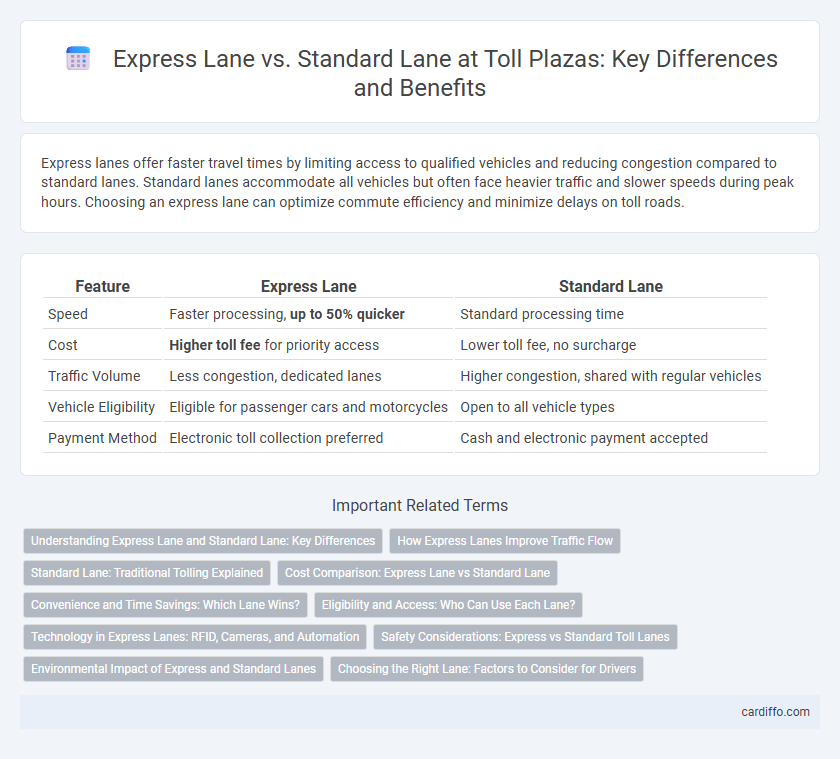Express lanes offer faster travel times by limiting access to qualified vehicles and reducing congestion compared to standard lanes. Standard lanes accommodate all vehicles but often face heavier traffic and slower speeds during peak hours. Choosing an express lane can optimize commute efficiency and minimize delays on toll roads.
Table of Comparison
| Feature | Express Lane | Standard Lane |
|---|---|---|
| Speed | Faster processing, up to 50% quicker | Standard processing time |
| Cost | Higher toll fee for priority access | Lower toll fee, no surcharge |
| Traffic Volume | Less congestion, dedicated lanes | Higher congestion, shared with regular vehicles |
| Vehicle Eligibility | Eligible for passenger cars and motorcycles | Open to all vehicle types |
| Payment Method | Electronic toll collection preferred | Cash and electronic payment accepted |
Understanding Express Lane and Standard Lane: Key Differences
Express Lanes offer faster travel by utilizing dynamic toll pricing that adjusts based on real-time traffic conditions, reducing congestion and travel time for eligible vehicles. Standard Lanes operate with fixed toll rates and usually experience higher traffic volumes, leading to longer travel times during peak hours. Choosing between Express and Standard Lanes largely depends on the driver's need for speed and willingness to pay variable tolls versus fixed charges.
How Express Lanes Improve Traffic Flow
Express lanes utilize dynamic toll pricing to manage demand, reducing congestion by encouraging drivers to opt for faster, less crowded routes. These lanes maintain consistent speeds and lower travel times compared to standard lanes, which often experience stop-and-go traffic due to higher vehicle volumes. The improved traffic flow in express lanes decreases overall roadway congestion, enhancing travel efficiency and reducing emissions on multi-lane highways.
Standard Lane: Traditional Tolling Explained
Standard Lanes use traditional tolling methods where drivers stop or slow at toll booths to manually pay fees via cash or card, often causing delays during peak hours. This system relies on physical toll collection infrastructure and staff, maintaining a straightforward but slower process compared to electronic tolling in Express Lanes. Standard Lane tolling remains prevalent on many highways, especially in areas without widespread electronic tolling technology.
Cost Comparison: Express Lane vs Standard Lane
Express lanes typically charge dynamic toll rates that fluctuate based on traffic congestion, often resulting in higher costs during peak hours compared to standard lanes with fixed toll rates. Standard lanes offer predictable, lower toll fees but may incur longer travel times due to congestion, whereas express lanes provide faster travel in exchange for premium pricing. Cost-conscious drivers must weigh the value of time savings against the higher toll expenditures associated with express lane usage.
Convenience and Time Savings: Which Lane Wins?
Express lanes offer significant time savings by allowing vehicles to bypass long queues typical in standard lanes, reducing average wait times by up to 50%. These lanes utilize electronic toll collection systems like RFID or transponders, enhancing convenience by eliminating the need for cash payments or stopping at toll booths. Choosing an express lane maximizes travel efficiency, making it the preferred option for drivers prioritizing speed and convenience.
Eligibility and Access: Who Can Use Each Lane?
Express lanes are designated for vehicles meeting specific criteria such as carpool occupancy, low-emission vehicles, or those with electronic toll tags, offering faster access and reduced toll rates. Standard lanes accommodate all vehicles without eligibility restrictions but often experience slower traffic and higher toll fees. Access to express lanes typically requires pre-registration or proof of eligibility, while standard lanes remain open to the general public.
Technology in Express Lanes: RFID, Cameras, and Automation
Express lanes leverage advanced technology such as RFID systems, high-resolution cameras, and automated toll collection to enhance traffic flow and reduce congestion. RFID tags enable seamless vehicle identification and electronic toll payments without stopping, while cameras capture license plate data for enforcement and billing. Automation in express lanes minimizes human intervention, increases efficiency, and supports dynamic pricing models to optimize road usage.
Safety Considerations: Express vs Standard Toll Lanes
Express lanes reduce congestion and decrease collision risk by maintaining steady traffic flow compared to standard lanes, which often experience stop-and-go conditions leading to rear-end accidents. These lanes typically have enhanced monitoring systems and speed controls that promote safer driving behaviors. Safety studies show a 15-20% reduction in accident rates on express toll lanes relative to standard toll lanes.
Environmental Impact of Express and Standard Lanes
Express lanes reduce vehicle idling time by maintaining steady traffic flow, significantly lowering greenhouse gas emissions compared to standard lanes where stop-and-go traffic increases fuel consumption. Studies show that express lanes cut CO2 emissions by up to 20% due to smoother speeds and fewer abrupt stops. Implementing express lanes contributes to urban air quality improvement while also easing congestion-related pollution hotspots typical of standard toll lanes.
Choosing the Right Lane: Factors to Consider for Drivers
Choosing the right lane at toll plazas depends on factors such as vehicle type, payment method, and traffic conditions. Express lanes are ideal for drivers with electronic toll tags seeking faster passage and minimal stops, while standard lanes accommodate cash payments and larger vehicles. Evaluating these elements ensures efficient travel and optimized toll plaza throughput.
Express Lane vs Standard Lane Infographic

 cardiffo.com
cardiffo.com